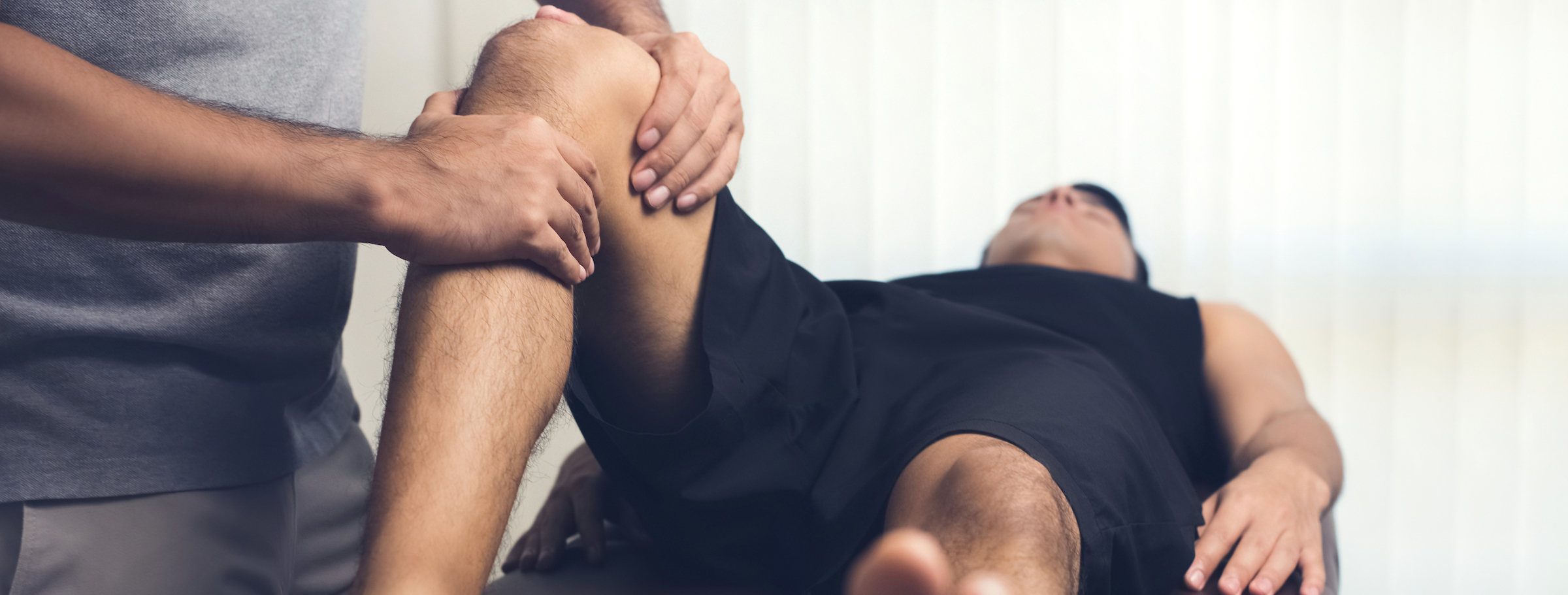
Osteoarthritis of the knee
If your knee hurts when you move it and the pain does not subside after resting it, this may be an indication of osteoarthritis.
Osteoarthritis occurs when the articular cartilage becomes thinner and no longer protects the joint. If left untreated, osteoarthritis of the knee can have a significant impact on your quality of life.
Quick facts
-
Common causes: the exact causes are varied and can be influenced by factors such as age, genetics, obesity, injuries and overuse.
-
Symptoms: pain in the knee, stiffness, swelling and limited mobility.
-
Diagnosis: Diagnosis is usually made by clinical examination, X-rays and, if necessary, MRI scans.
-
Treatment options: Knee osteoarthritis is a degenerative disease that cannot be cured. Treatment can be conservative and includes physical therapy, medication and lifestyle changes. In advanced cases, surgery, such as knee arthroplasty, may be necessary.
Causes

Osteoarthritis occurs when the cartilage tissue in the knee is damaged. If the cartilage is damaged, the joint can no longer move smoothly and pain occurs.
Cartilage damage can be caused by injuries to the knee joint, e.g. a torn cruciate ligament or broken bone near the knee, or by anatomical misalignments of the knee or legs of different lengths. There are cases in which severe overweight leads to damage to the cartilage and thus to knee osteoarthritis.
Symptoms
The first signs of knee osteoarthritis initially only occur under physical stress. Over time, they become stronger and more frequent.
-
In addition, so-called pain at rest occurs, i.e. pain suddenly occurs in the knee during sleep or periods of rest.
-
The progression of knee osteoarthritis is also reflected in accompanying symptoms, e.g. joint stiffness or severe pain in the morning and evening.
-
The pain feels dull and depending on which area of the knee is affected, this pain can occur on the inside or outside of the knee.
-
Sensitivity to pressure and stiffness of the knee increase more and more. This leads to a weakening of the muscles and you get the feeling of an unstable knee.
-
In certain cases, pain comes in episodes and is accompanied by swelling and burning pain.
Diagnosis
If pain in the knee joint is so severe that it impedes movement, it is important to have the cause of the pain investigated.
During the examination, the patient is asked a series of questions to find out when and how the pain presents itself.
This is followed by a comprehensive clinical examination to assess the restrictions to movement in more detail and to localise the pain.
An X-ray of the knee joint is then taken, as well as an X-ray of the full leg in a standing position to determine the load-bearing axis and the position of the knee joint.
If there are any uncertainties, an MRI (magnetic resonance imaging) may also be carried out. This allows the doctor to make a better assessment of the cartilage in and around the knee joint. Once all these tests have been carried out, the results are discussed with the patient and a decision is made as to how to proceed.
The cartilage damage is divided into different stages of osteoarthritis, according to the extent of the wear.
Superficial damage (small tears) of the articular cartilage can occur, but there are also types of damage that affect the entire cartilage. This damage exposes the surface of the bone and causes pain.
Stadiums
Cartilage damage is divided into four stages:
- Stage 1: soft cartilage
- Stage 2: rough surface with cracks
- Stage 3: deep cracks in the cartilage that go to the bone
- Stage 4: complete deterioration of cartilage with exposed bone

Pangonarthrosis
Pangonarthrosis, also known as panarthrosis, is a degenerative joint disease that can affect several joints in the body. This condition is relatively rare, but occurs mainly in older people. The causes of panarthrosis include normal wear and tear of the joints, but also obesity and repetitive strain.
The symptoms of pangonarthrosis are similar to those of knee osteoarthritis, but they affect several joints at the same time. The most common signs include pain, swelling, stiffness and limited joint mobility.
As with knee osteoarthritis, the treatment of pangonarthrosis aims to alleviate pain, improve mobility and maintain quality of life.
Our services for your knee treatment
Conservative therapies
Surgery is not always necessary to treat osteoarthritis of the knee. Conservative therapies are often sufficient to reduce pain. These include a joint-friendly lifestyle, weight reduction, physiotherapy (e.g. according to GLA:D) or physical therapies. With the help of special insoles and medication (for pain and cartilage strengthening), the knee can be relieved and the cartilage protected or strengthened.
Treatment options:
-
Anti-inflammatory and pain-relieving medication
-
Medication and substances for cartilage strengthening
-
Injections into the joint with lubricants (hyaluronic acid or autologous blood) and anti-inflammatory medication (cortisone)
-
Aids such as walking sticks, insoles, health shoes
-
Changing lifestyle habits with regard to sport, obesity, diet, etc.
-
These measures can reduce osteoarthritis pain and slow down the progression of cartilage wear. Unfortunately, osteoarthritis itself cannot be stopped or cured.
Injections with hyaluronic acid
Hyaluronic acid can be used to reduce friction in the affected cartilage surface of the knee. The hyaluronic acid preparation used for this purpose is a synthetically produced lubricant. It is injected directly into the affected joint. After the injection, it is possible to move the joint better. The additional «lubrication» means that the joint is less irritated. This prevents joint inflammation and reduces pain associated with osteoarthritis.
The result of the lubrication injections depends on the stage of osteoarthritis. The majority of patients report not only pain relief, but also an improvement in their own quality of life. The treatment consists of three injections, lasts for a certain period of time and can be repeated at any time.
Surgical treatments
If conservative treatments do not have the desired effect, surgery is usually necessary to treat knee osteoarthritis.
A knee prosthesis is used to replace a painful or restricted knee joint with an artificial joint implant. This procedure is often used in patients with osteoarthritis to relieve pain and restore mobility.
The knee prosthesis consists of various components that mimic natural joint movement, allowing the knee to function smoothly again.
The procedure to implant a knee prosthesis is usually performed under general anaesthetic and takes several hours. The Swiss Medical Network uses the latest technical robots such as the ROSA® and the fast track procedure agile+® to perform this procedure as precisely as possible. After the operation, patients usually have to start physiotherapy to strengthen the muscles and improve the mobility of the new joint. Recovery time can vary, but many people are able to walk normally and carry out their daily activities without pain after a few weeks.
Aftercare
Depending on the procedure, follow-up treatment can be carried out on an outpatient or inpatient basis. The period of follow-up treatment involves stabilising the new joint and training movement sequences. The patient should also learn what he or she needs to consider in everyday life. Rehabilitation is carried out over a period of three weeks and consists of movement therapy, gait training and physiotherapy.
Frequently asked questions answered by knee specialists
Can osteoarthritis of the knee be completely cured?
Osteoarthritis of the knee is a chronic disease and cannot be cured. All the treatment methods are designed to relieve pain and to enable those affected to live as normal a life as possible.
What helps against osteoarthritis of the knee?
Joint pain can be alleviated by strengthening the muscles. There are plenty of exercises for this that are easy to do. The important thing here is regularity – if you want to improve joint function, then regular exercise is a must.
How long does it take before you can move normally again?
The muscles recover within six weeks of the operation, at which point the joint has adequate support. In normal cases, it is possible to return to work and resume light exercise after three months.










